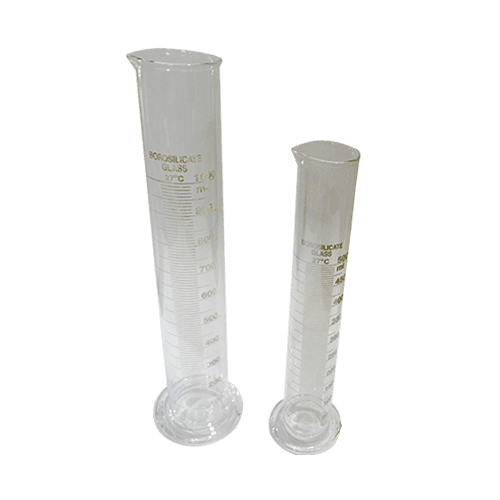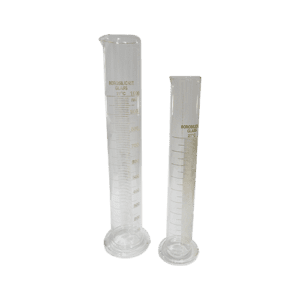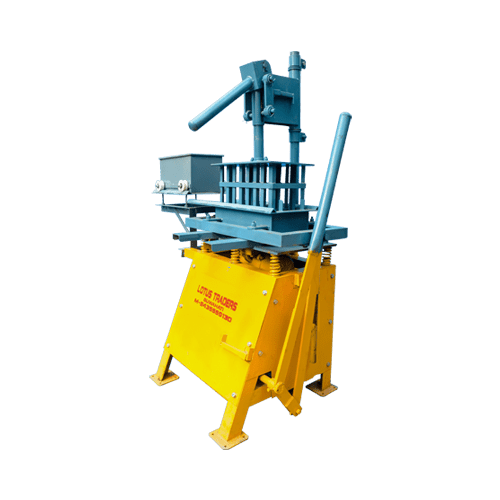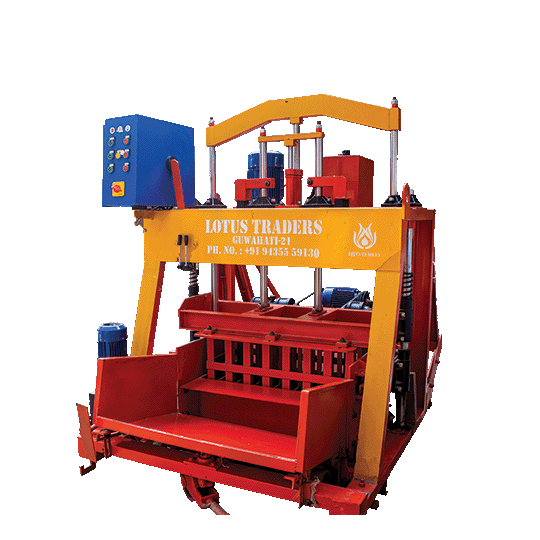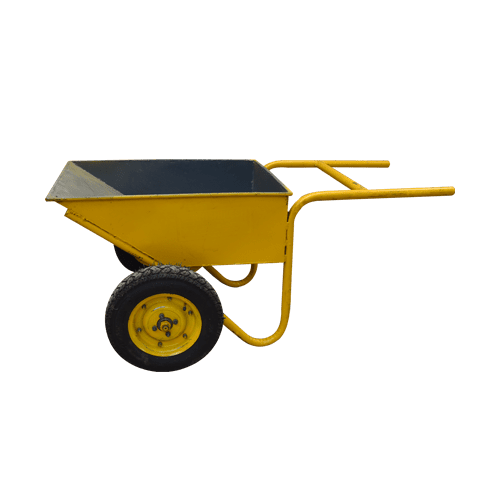Measuring Cylinder
- High Quality Materials
- Compliance With Standards
- Clear Product Information
- Warranty & Support
- Product Testing & Certification
- Delivery & Policy
- Ask a Question
- Estimated Delivery: 5 Days – 10 Days
Information About Measuring Cylinder:
Measuring cylinder
INTRODUCTION
Measuring cylinder is a laboratory glassware that is designed for measuring volumes of liquids accurately. This cylindrical tube is usually made of transparent glass or plastic; it has a narrow vertical spout, and its markings are arranged along the vertical axis. The graduated scale is such that it provides precise measurements of the volume of liquid within the cylinder.
The measurement chamber of the measuring cylinder is labelled with calibrated lines, each indicating a specific volume increment. These graduations allow for the accurate measurement of liquids in millilitres or any other appropriate unit. The thin neck helps one to pour liquids with minimal spillage and also allows them to transfer the contents into other containers in a controlled manner. Measuring cylinders are available in different sizes that can accommodate varying volumes of liquids from small ones for intricate experiments to bigger ones for larger amounts. As these cylinders are widely utilized in chemical, biological and physics laboratories to do things like titrations, dilutions, and accurate volume measurements.
A measuring cylinder is used by pouring the liquid into the cylinder and read out the volume by aligning of the liquid level with an appropriate graduation line. As such, an accurate measurement is very critical in ensuring reliable experimental results; hence a measuring cylinder is one important instrument in scientific research and education. In conclusion, measuring cylinders are essential tools in laboratories as they offer a straightforward yet efficient technique for determining liquid volumes. They are precise, easy to use and versatile tools for scientists and students who seek accurate and reproducible measures.
KEY FEATURES
A measuring cylinder is a hollow cylinder marked with a scale to give the volume of liquids. Its key features include:
Graduated Scale: The measuring cylinder has a side scale that is usually marked in millilitres (ml) or cubic centimetres(cm³). This scale measures liquid volumes accurately.
Base and Stability: It has the stable base to avoid tipping and spilling. This ensures the accurate measurements and prevents accidents.
Transparent Material: Measuring cylinders are mostly manufactured from transparent materials, for example glass or plastics so that people can easily view the level of liquid and make correct measurements.
Spout: The top of the cylinder has a pour spout that allows controlled pouring of liquids without any sort of spillage.
Tapered Design: The cylinder is often slightly tapered at the top. This design reduces errors associated with meniscus formation – a concave or convex curve of the liquid surface.
Calibration: Measuring cylinders are calibrated to ensure accuracy. Calibration involves creating points on the container at certain distances corresponding to familiar volumes.
Precision and Accuracy: Measuring cylinders are designed to be precise and accurate in volume measurement hence can be used in many scientific and laboratory applications.
Temperature Resistance: Measuring cylinders may have temperature change resistance depending on material, and they can be used with different liquids at various temperatures.
Versatility: There are available in several sizes that can accommodate different volumes, depending on the scale of experiments and applications carried out.
Ease of Cleaning: Measuring cylinders are easily cleaned, which is important for maintaining accuracy in future measurements and preventing cross-contamination.
Overall, the aspects of the measuring cylinder make sure that liquid volumes are measured accurately and reliably in scientific experiments and laboratories.
UNDERSTANDING THE WORKING PROCEDURE
A measuring cylinder is a standard lab tool used for precise volume measurement of liquids. It is usually made of glass or plastic; it has a cylindrical shape with a narrow scale along its side. Using a measuring cylinder is a procedure that involves several important steps. First, make sure the measuring cylinder is clean and dry.
Ensure it is placed on a flat level surface for accuracy in readings. Place the liquid that needs measuring into the cylinder until it can be seen on a reading scale. The bottom of the curved liquid surface, known as the meniscus is read for volume. Surface tension results in the liquid curving slightly at its edges creating what is known as the meniscus. It should be measured from the lowest point of the meniscus to ensure accuracy.
When reading, the eye should be at the same level with the liquid to prevent parallax error. Parallax error happens when the measure is observed from an angle and drawing some inaccuracies. Read where the meniscus meets the gradient and note down in millilitres or cubic centimetres. It should be noted that measuring cylinders are limited in terms of accuracy. The accuracy relies on the size and calibration of the cylinder. A finer scale usually results in more precise measurements with smaller increments.
It is important to ensure the regular calibration and proper handling of a measuring cylinder in scientific experiments and analyses for obtaining reliable results.
USAGE AND APPLICATION
The measuring cylinder is a cylindrical receptacle marked with graduated lines for the accurate measurement of liquids. It is most often used in laboratories where liquid volumes need to be accurately dispensed or measured. In scientific experiments, measuring cylinders are significant as they help determine the volume of a liquid accurately.
The side of the cylinder is marked with graduated lines that enable accurate measurements generally in millilitres or cubic centimetres. This makes it a robust tool for tasks like preparing chemical solutions, performing titrations, or examining the outcomes of reactions. The design of the measuring cylinder allows users to pour liquids into it and out of it easily, with minimal risk of spillage and ensuring that dispensing is controlled.
Its elongated cylindrical shape helps in minimizing the surface area that is exposed to surrounding environment, thus reducing evaporation, and ensuring the intactness of the liquid used for measurement. In addition, preferred measuring cylinders for transparent or translucent liquids as the graduated markings are visible through the container. This helps to get the correct readings without further transferring between containers.
Measuring cylinders are essential in the academic environment for teaching students volume measurements, precision in scientific experiments. They offer a practical environment in which learners can engage in the practice of correct measuring methods and acquire fundamental laboratory skills. To sum up, the measuring cylinder is an essential tool in laboratories wherein scientists can accurately measure volumes of liquids for diverse scientific purposes ranging from chemical testing to educational demonstration.
ADVANTAGE AND BENEFIT
A measuring cylinder is an important piece of equipment in scientific laboratories for precise volume measurement. This technique is distinctly advantageous especially because of its precision that enables scientists to obtain reliable and reproducible results. The cylindrical shape is narrow graduated neck which makes accurate readings possible especially when dealing with small quantities of liquids.
The adaptability of a measuring cylinder is another great advantage. It is capable of accommodating large ranges of volumes and thus it is suitable for both big scale and small scale experiments. This adaptability makes it unnecessary to use several measuring tools thus making the work in lab less complicated and facilitating efficiency. Another significant advantage is the transparency of the measuring cylinder.
They are usually made of clear glass or plastic and allows easy visual observation of the level of liquid in them. This transparency allows for precise measurements as parallax errors, where the perceived position of the liquid changes depending on one’s viewing angle, are reduced. Researchers are able to confidently place their eye level parallel with the meniscus – which is the curved surface of the liquid – and obtain accurate measurements of volume. Additionally, measuring cylinders encourage safe handling of dangerous chemicals.
They are designed in a way that ensures there is controlled pourage, thus reducing spillage and the resultant risks. This feature is particularly important when working with toxic or reactive materials because it makes accidents less likely and ensures the safety of laboratory personnel. In other words, the precision, versatility, transparency and safety of the measuring cylinder makes it an essential factor in laboratories supporting reliability of scientific experiments.
A measuring cylinder is a cylindrical container, marked with graduated lines that enable it to measure the volume of liquids accurately.
Do not use abrasive materials that may scratch the graduated markings.
Although versatile, some corrosive or reactive liquids may demand the use of specialised containers in order to prevent damage from being inflicted upon measuring cylinder.
Treat with care to avoid breakages, take the right cylinder size for the volume and clean well between measurements to eliminate contamination.
Make sure your eye is directly in line with the meniscus of liquid to avoid distortion due to angles; this will minimize parallax error.
They come in many forms, such as graduated cylinders that have only one scale, and burettes with a finer marking to measure with more precision.
Yes, measuring cylinders are available in different sizes and they can be used to measure a wide range of volumes. Different sizes meet the needs of different measurements.
The primary function is to measure volume of a liquid within acceptable parameters. It is quite common in experiments and routine laboratory work.
The curved surface of the liquid is called meniscus and measurement is made at its lowest point.


